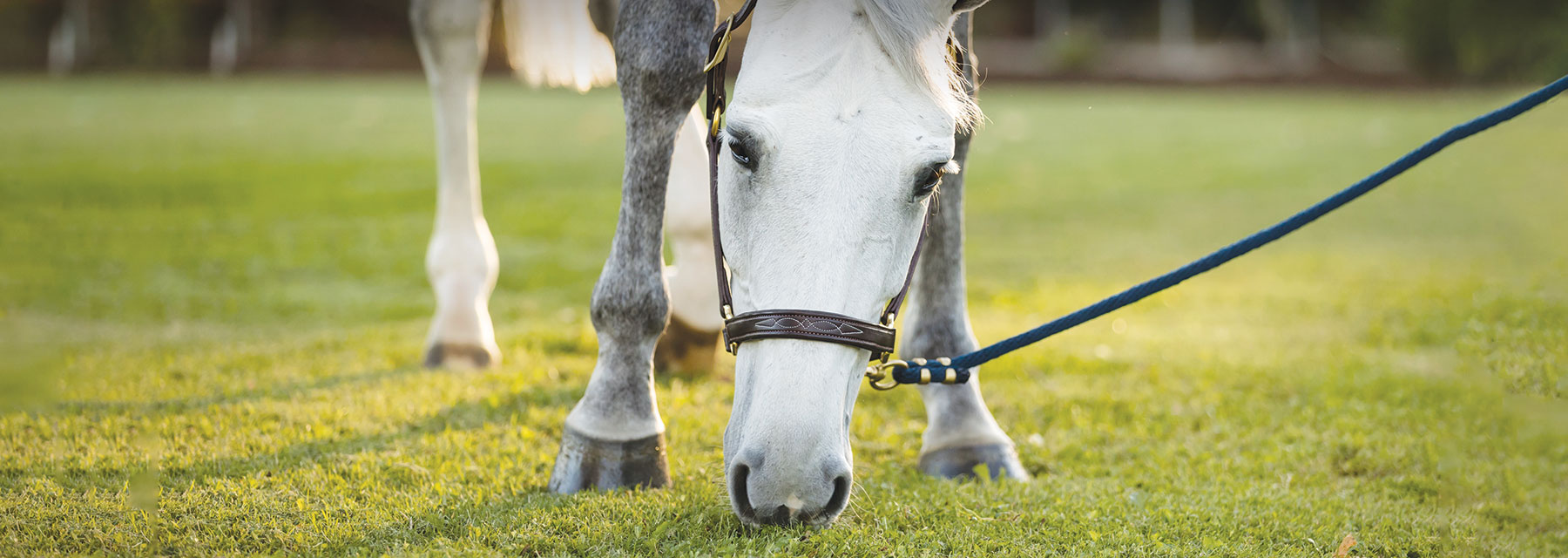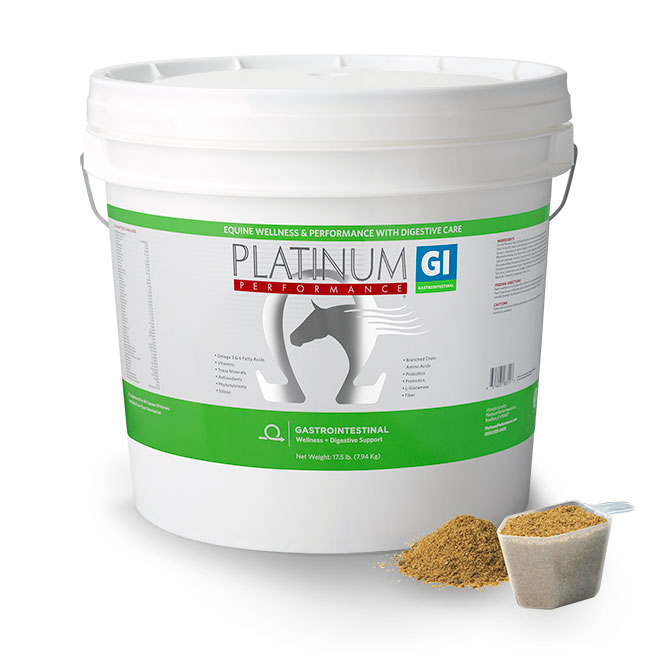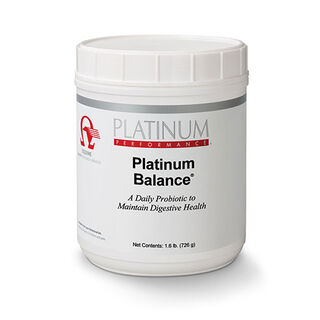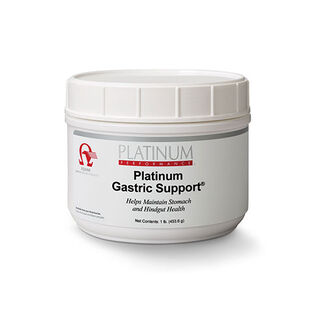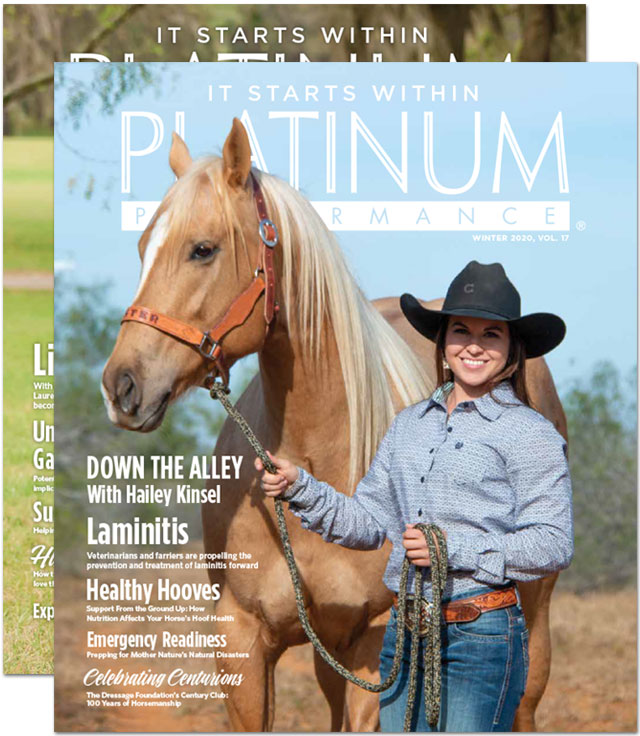While Gas is a Normal Byproduct of Digestion, Excessive Production or Intestinal Blockage can Lead to Distention, Bloating and Abdominal Pain
As a grazing herbivore, horses require a steady flow of fibrous forage for a healthy gastrointestinal tract. The equine hindgut (cecum and colon) plays a significant role in digestion, heavily relying on a vast microbial population that works in balance to ferment the fibrous components of plants that make up the majority of the equine diet. Under normal circumstances, billions of innate bacteria and protozoa slowly ferment the structural carbohydrates of the ingested forage resulting in short chain fatty acids, or SCFAs, and gas. The resulting SCFAs, often called the volatile fatty acids — butyrate, propionate and acetate — are a substantial source of energy for horses. Gas is a byproduct of normal digestive tract operations, and the average horse produces copious amounts of it every day. However, if excessive amounts of gas are produced or it is unable to pass through the many turns and rotations of the gastrointestinal tract, particularly in the colon, it can build up and cause the distention, bloating and abdominal pain that is known as gas colic.
Gas colic is the most common type of colic in horses. It usually causes mild to moderate pain in the stomach or intestines and can resolve on its own or may require medical treatment by a veterinarian. Intestines that become overfilled with gas can displace or twist on themselves, known as a torsion, that often requires immediate surgery. A veterinarian should be called at the first sign of colic.
About Gas Colic
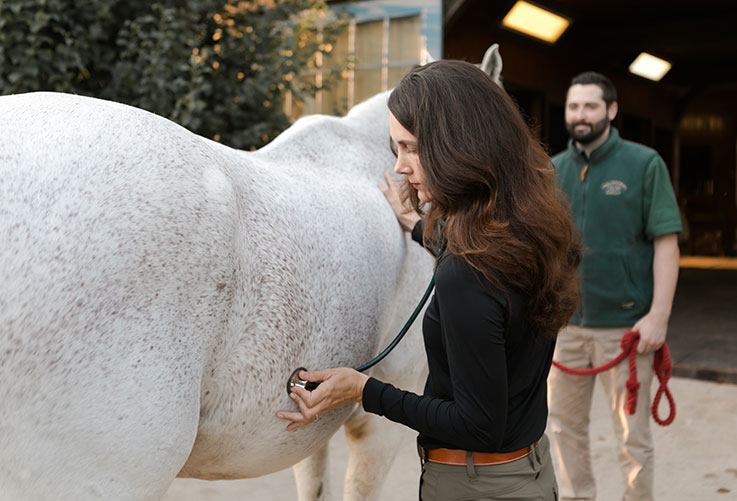
Colic is the top cause of death in horses. Many times, gas colic cases are mild and easily treated especially when caught early. Knowing the symptoms of colic can be very helpful for early intervention and preventing a small issue from becoming dangerous.
Signs of Colic
- Pawing
- Kicking, biting or looking at the belly
- Repeatedly lying down and getting up
- Stretching out as if to urinate, without doing so
- Depression or “zoned out” expression
- Leaving food after a meal or being completely disinterested in food
- Lack of bowel movements
- Reduced or absent digestive sounds
- Inappropriate sweating, rapid breathing and/or flared nostrils
It is important to contact your veterinarian at the first sign of colic.
Dietary Risk Factors
Nearly all colic episodes involve an element of gas accumulation, and the underlying reason for gassy colics are often not clearly identified. However, several dietary risk factors may be involved, such as:
- Limiting forage
- Abrupt diet changes
- Large meals, especially high in starch
- Dietary stress
- Inactivity or stall confinement
- Unchewed or poorly chewed feed
- Dehydration
Management Strategies to Deal With Gas Issues in Horses
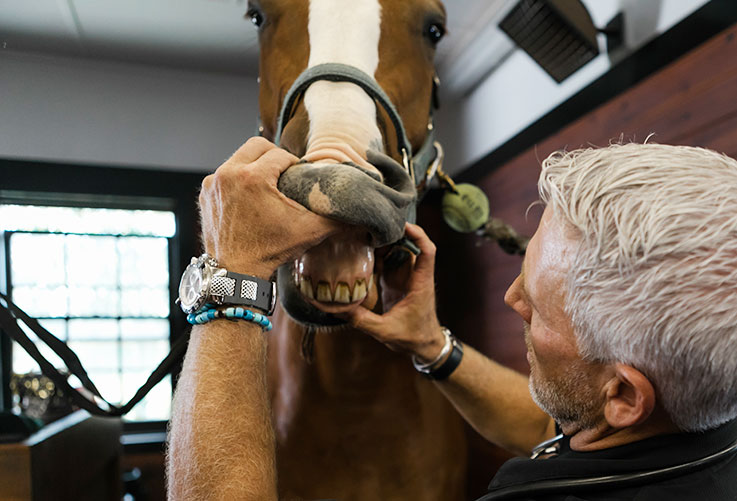
1. Dental Check-Up
As part of routine wellness with your veterinarian, teeth should be checked and shaped as needed. Poorly chewed or unchewed food is more difficult to digest and may reach the hindgut, disrupting the delicate hindgut flora and causing increased gas production. For older horses that may have ongoing dental issues, including worn teeth or tooth loss, consider feeding softer foods, like a commercial senior feed. Soaking all feeds, including concentrates, cubes, pellets, etc., may help seniors or horses with dental issues more easily eat.
2. Avoid Big and Rich Meals
The risk of colic significantly increases with elevated levels of dietary starch, a common non-structural carbohydrate component of cereal grains and many concentrated feeds, several studies confirm. Large meals that contain high levels of starch and sugar can potentially overwhelm the small intestine’s absorptive capabilities and spill over into the hindgut where they are fermented and create gas.
Moreover, there are some instances when rapidly-growing or stressed pasture grass can be too rich for some horses due to their sugar content, specifically from the oligosaccharide fructan. These specially-adapted sugars are chains of fructose molecules found in cool season grasses, such as fescue and perennial ryegrass. They are resistant to the enzymes of the foregut (stomach and small intestine) and pass undigested into the hindgut where they undergo rapid fermentation producing lactic acid, shifting the cecal pH and leading to increased gas and bloating. Lush, immature spring grass also can contain a high content of sugar. Stressed grasses caused by major temperature shifts can cause pasture grasses to store sugar and quickly become a potentially rich feed. If possible, when dealing with new spring grass or stressed pastures, turn out horses for a limited amount of time and increase pasture access over 14 days or more to allow the digestive tract to acclimate to this “new” feed.

3. Consistent Access to Forage
Consistent access to pasture or hay helps feed the beneficial microflora in the hindgut allowing these important microbes to function optimally. The most important thing you can do is to provide a 24/7 forage source for your horse. Allowing horses as much turnout as possible, and having hay available when stalled or during times of the year when grass is unavailable is critical for maintaining a healthy gut. Horses should consume approximately 2% of their body weight in forage each day. For a 1,000-pound horse, that is 20-pounds of hay daily. If other feeds are provided, the diet should include at least 70% forage — if not more. Avoid long periods with an empty stomach. Horses with consistent access to forage actually tend to self-regulate intake better as there isn’t the stress of running out or being without food. This can decrease the urge to quickly eat or “bolt” feed that can lead to inefficient chewing and undigested feed reaching the hindgut microbes, resulting in excess gas production.
If your horse is an easy keeper, consider a slow feeder or small-hole hay net to increase the time it takes him to eat. This allows the simulation of grazing and slow fiber trickle through their digestive tract.
4. Make Feed Changes Gradually
The hindgut microflora adapts to the specific foods your horse eats. Many experts think abrupt feed changes are the most common cause of excess gas. Sudden changes can disrupt the microbial balance causing a variety of issues, including increased gas production and a decrease in intestinal pH as lactic acid production increases. The hindgut pH should remain consistent, around 6.5 to 7, to facilitate ideal microbial conditions and maintain proper digestive functioning and hindgut health.
Feed changes should be made gradually to allow the hindgut microbes to acclimate. It is ideal to make the change over at least 14 days or more for particularly-sensitive or colic-prone horses. Slowly adding the new feed in with the current, and gradually increasing the ratio of the new feed each day until the transition is complete. Be aware when your feed sources are running low, so that you will have ample time to re-order and be able to slowly introduce anything new.
This is recommended for concentrated feeds, but it is also suggested for new forages. In fact, feeding a new hay or even a new batch of the current hay, may be more influential than anything regarding gut adjustment. In a 1999 study by Cohen et al., the strongest dietary risk factor was found to be a change in hay type within the previous two weeks, which increased the risk of colic by nearly 10-fold. Maintain your feeding schedule, including on weekends. Bran is a classic feed given infrequently. It is better to give a bran mash daily or not at all because occasional bran intake can increase gas. Moldy feed and hay can also cause a major and abrupt bacterial shift and result in a gas issue. Watch for mold and smell feeds for any “off” odors.
5. Support the Gut
Supplementation with prebiotics, probiotics and glutamine help support the beneficial microflora that reside in the digestive tract.
Prebiotics nourish the “good” bacteria and support fiber digestion.
Probiotics are beneficial bacteria or yeast strains that support nutrient absorption, feed efficiency and help restore the good bacterial community in the gut. Probiotics are beneficial to any horse and are often advocated during feed changes, travel or antibiotic use.
Glutamine maintains healthy intestinal cells and supports immune health. The vitamin B complex also supports a healthy GI tract and helps to ensure proper digestion. A supplement that contains colostrum is often suggested to support gastric health, normal intestinal cell growth and help maintain and balance gut pH.
Why Are Probiotics Good?
The hindgut microbiome — made up of billions of beneficial bacteria, fungi, protozoa and enzymes — primarily ferments and digests plant fiber and other feedstuffs. These microbes must be healthy in order for a horse to digest and metabolize the feed he consumes. Healthy microbes are necessary for maintaining normal gas, reducing gas production and for the synthesis of nutrients, including several vitamins.
Probiotics have been known for centuries to help maintain intestinal microbial balance. Probiotics — live bacteria or yeast microbes — add to the general microbial population or support the activity and numbers of “good” organisms that naturally reside in the horse.
Two types of yeast strains, Saccharomyces cerevisiae and Saccharomyces c. boulardii, are examples of probiotics used to support nutrient digestibility and utilization in horses.
When Should I Supplement?
Any horse can benefit from daily probiotic due to their strong correlation with gastrointestinal balance and healthy nutrient digestion.
Prebiotics vs. Postbiotics?
Prebiotics support the health of the naturally-existing hindgut microbes. Prebiotics, such as mannan oligosaccharides and the fermentation products of the fungus Aspergillus oryzae, feed the innate, beneficial bacteria so they are able to grow and multiply, resulting in healthy forage digestion.
Postbiotics are the end result of microbial activity. These non-living, organisms and/or their metabolic byproducts of the fermentation process help to exert many of the health benefits of pre- and probiotics. Examples of postbiotics include some vitamins, enzymes and short-chain fatty acids — a major energy source for the horse. Postbiotics support immune health, digestion and generally help to maintain a healthy gastrointestinal system.
6. Less Stress
Nutritional stress may develop through a change in routine, alterations in diet, limited access to grazing, stall confinement or dehydration. Ulcers can occur, and gas can result from ulcers that interfere with digestion and allow undigested feed to enter the hindgut. Having forage to “graze” on throughout the day can significantly help decrease the likelihood of ulcers. Turning out a horse can help ease general stress and provide a necessary “recess” for mind and body. Adding alfalfa to the diet can help buffer the stomach. Using long-stem hay instead of hay pellets can prolong eating time and as a result offer the buffering benefits of continuous forage.
7. Fresh, Clean Water Available
The digestive tract needs hydration for proper motility and to keep things moving through. Soaking concentrates, hay cubes and pellets can increase your horse’s general water intake as well. Plain, white salt should also always be available to meet sodium chloride requirements as well as to increase thirst and prevent dehydration. If your horse does not like to use a salt block, add two tablespoons of salt to their feed daily.
Automatic water devices or large water troughs can make it difficult to monitor fluid intake. If you are unsure that your horse is drinking enough, instead hang two large water buckets to more easily gauge consumption.

PHOTO BY ELIZABETH HAY PHOTOGRAPHY
8. Activity Improves Digestive Motility
Horses that spend the majority of the day in a stall are at a higher risk of colic than animals that are turned out. Intestinal muscle motility is needed to push gas through the digestive tract. These muscles use peristalsis — contracting and relaxing — to gently move ingested food and waste products, including gas, through its entire length. When horses are inactive or are unable to move around, such as when confined to a stall, gut motility is decreased and gas cannot be expelled as easily. Without consistent movement, peristaltic action can be reduced and gas can build up and intensify.
The slow, low impact of grazing and walking about greatly improves digestive motility. Low-impact lunging, walking under saddle, exercising on a treadmill or simply hand walking are all ways to support gut motility and are often suggested if a horse is showing signs of a mild gas colic.
Platinum Formulas for a Healthy Digestive Tract
Platinum Performance® GI is a comprehensive foundation formula that combines wellness ingredients including omega-3 fatty acids, antioxidants and micronutrients with pre- and probiotics to support digestive efficiency and help maintain an optimal weight.
Platinum Balance® is a pre- and probiotic blend with added glutamine to support gastric and hindgut health. The ingredients work synergistically to nourish an efficient and thriving hindgut microbiome allowing the horse to get the most out of the daily feeds consumed.
Platinum Gastric Support® focuses on a healthy stomach and hindgut environment. It supports healthy levels of gastric acid and intestinal proteins combined with S. boulardii, a daily probiotic, to support intestinal microflora.
